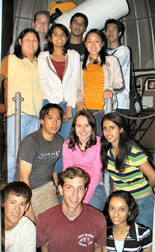 |
New Jersey Governor's School in the Sciences at Drew University |
 |
Drew Links |
|
| Team Projects | |
| NJGSS Home | |
| About NJGSS | |
Related Links |
|
| Drew University | |
2004 Team 6 |
||||||||||
EVOLUTION OF THE UNIVERSESwati Antala, Salina Bakshi, Jeffrey Barry, Kevin Chen, Benjamin Hsu, Arpan Patel, Payal Patel, Jena Song, Janelle Trinidad, Brian WexlerAdvisor: Dr. Sean Hendrick |
||||||||||
ABSTRACT Observations of specific objects and phenomena in space provide basic fundamental information on the evolution of the universe. Some stars, such as the Sun, will evolve into planetary nebulae, while a larger star will explode as a supernova. Examining planetary nebulae will show the final stage in the evolution of Sun-like stars. The Ring Nebula and the Dumbbell Nebula were observed, and composite constructions of each planetary nebula were created after observation with red, green, and blue filters. It was discovered that the nebulae consisted of hydrogen, double ionized oxygen, neon, and helium. Observations of globular clusters show the evolutionary states of many stars at once. M13 and M56 were the two globular clusters observed. Hertzsprung-Russell diagrams were created for each cluster, portraying the relationship between magnitude and temperature of various stars in a cluster. Due to limited resolution, the diagrams do not show conclusive results, but they do indicate the point where stars leave the main hydrogen-burning stage of evolution. The evolution of galaxies can be represented by a Hubble Tuning Fork, displaying elliptical, spiral, and barred spiral galaxies. Several galaxies were observed and the spiral branch of the Hubble Tuning Fork was created. Examples of galactic mergers were also viewed. The study of each of these phenomena will help shape our perception of the evolution of the universe. |
||||||||||
|
|
|||||||||
